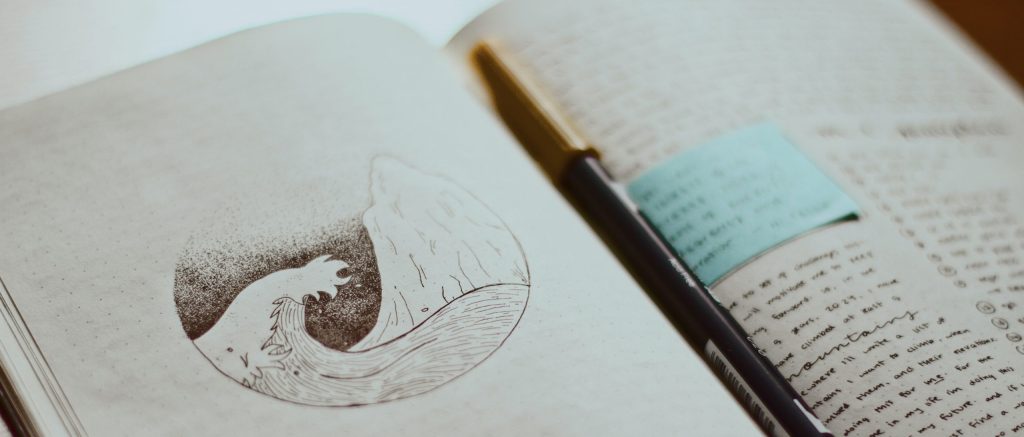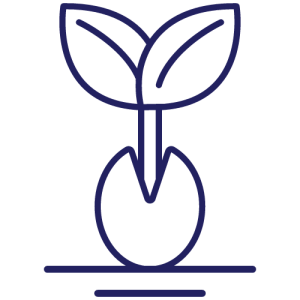Reflective practice in context: Art and Design
“It’s on the strength of observation and reflection that one finds a way. So, we must dig and delve unceasingly.”
– Claude Monet
What is reflective practice in art and design?
Reflective practice is integral to your learning and development in art and design. It’s the process of thinking deeply about an experience or piece of work and critically reflecting on it to gain insights into what you’ve learnt and how it can help you make future decisions.
You may have already started your reflective practice without being aware of it, by keeping a personal journal, a commonplace book, or an art diary. Doing reflective activities at uni will help develop your skills and knowledge and is a way for your educators and mentors to assess this progress. During your studies, you’ll learn to use reflection more intentionally to improve your creative practice, and these are skills you’ll continue to benefit from for the rest of your career.
Reflection is used in a multitude of ways in art and design. Select the expandable headings to read examples of some of the activities that you might do as an art and design student that involve reflection.

Why is reflective practice important?
It’s commonly accepted that doing the same thing over and over again is unlikely to achieve different results. Change and improvement require reflection, which gives us a chance to pause and look back on what’s happened so that we can look forward with stronger ideas of how to achieve our goals.
 Opportunities to grow
Opportunities to grow
Intentional reflection requires us to look closely at our mistakes (and our victories) and analyse why something happened and how it could’ve been different. This allows you to develop strategies to improve your practice and overcome challenges you might face as an artist or designer. Nothing is a ‘failure’ if you can turn it into a valuable learning experience. Being able to use these skills to learn from every experience means that even when things don’t turn out as you’d planned or wanted, the experience will offer you opportunities to grow your skills and knowledge and improve in your field.
Creativity and confidence
Reflective practice also helps you think more creatively, by requiring you to look at things from different perspectives and consider new approaches. Being able to look at situations from different angles and critically reflect on the best course of action also improves your decision-making skills. Having a better understanding of why something did or didn’t work out means you’ll be better informed next time, which builds your overall confidence.
 Philosophy, goals, and portfolios
Philosophy, goals, and portfolios
As an artist or designer, it’s crucial to develop your own philosophy and to understand your values and vision. These are things that inform your approach to your work and your professional identity, and help you understand which opportunities are right for you. Reflecting on your strengths, weaknesses, and interests will also help you develop short and long-term goals and figure out what you need to do to reach them.
Your journey towards these goals is the ideal subject for your reflective journal and inclusion in your portfolio. Documenting and collecting your reflections as you progress through your courses and career will help you build your professional portfolio, ensuring that it represents you, and how you’ve grown as an artist or designer. It will also prepare you to talk about the skills and knowledge you have gained in future job interviews.

Milestones, memories, and progress
Your collection of reflective work is something you can revisit as your career progresses. It can help you keep track of milestones and pinpoint moments when your perspective shifted. In future years, you might look back on journal entries and be reminded of a goal you had at the start of your studies that you’ve now achieved. You might notice repeated patterns in your experiences and decide to try something different – reflective practice will help you keep your work constantly evolving.

Evidence
Finally, reflection is a way to show evidence that you are developing in your field. Documenting your reflective thinking demonstrates to those assessing you and working with you that you have the necessary skills and knowledge and that you can learn from your challenges and successes.
Reflect
It’s your turn to do some reflection. These prompts are intended to spark your curiosity in your own work, and help you gain insights into your art or design journey. You might like to write your answers in a journal or blog post, discuss them with a friend or classmate, or just take a moment to think deeply about your response — whichever way you answer these prompts, you will be working on your reflective thinking skills.
- What initially attracted you to your field of art or design? Can you pinpoint a specific moment or experience that ignited your interest?
- What aspects of the things you have studied recently do you find most interesting or inspiring? Why do you think these topics resonate with you?
- What are your short-term goals in art or design? How do you plan to measure your progress in achieving them?
- What are your long-term aspirations? Do you have a vision for how you’d like to contribute to the world of art or design in the future? What are the key skills you will need to develop along the way?
- What goals do you have for your reflective practice as an artist or designer? What strategies or tools do you plan to use? Are you more interested in keeping a journal, making vlogs, or engaging in group discussions?
Reflective writing: Studio Knowledge Object
Design Studio courses are common in many types of art and design programs. They generally have a central theme or address a real-life problem and require students to experiment with putting theory into practice and doing hands-on work. A common assessment task in design studio courses is the Studio Knowledge Object (SKO), which records the learning and insights a student has gained during the studio. Reflecting on the design studio experience and what you have gained from it is a significant part of the SKO.
The SKO has three main sections:
1. Contextualisation
Put the field of inquiry into context so that a non-expert reader can understand the key issues and approaches you refer to in your reflection.
Example:
This studio, Design for social change: climate change and food security, looks at the social role and ethical practices of communication design. Social change is a major influence on professional communication design as design can help to connect people to global issues which appear incredibly complex…
2. Reflection
Reflect on your learning and key insights from the studio, describing specific activities, concepts or approaches and evaluating their impact.
Example:
The most useful and interesting insight I have gained from this studio is the importance of research methods for creating end-user profiles. Before this journey, design research (for me) was about making mood boards and identifying basic audience demographics. Without downgrading the importance of these methods, I now recognise…
3. Future Application
Discuss how you can transfer this new knowledge to other projects and how it might affect your future practice.
Example:
This studio has given me confidence that I can continue to develop my skills in systems thinking for social innovation and sustainable design strategies. Taking the time to actually look at successful projects and campaigns that promote sustainable and socially just ideals, made me realise that complex design tasks are achievable if we connect the right problem with the right audience in a way that hasn’t been tried before. In future projects,…
To read full examples of reflective writing for the SKO task, and learn more about structuring your reflective writing in design, explore the Studio Knowledge Object tutorial on RMIT Learning Lab.
To get a more general overview of reflective writing and some useful structure and vocabulary tips, check out the Reflective Writing page of this resource.
An artist on reflective practice
Developing a reflective practice that suits you will benefit you in your career whether you’re a mixed media artist, a UX designer, an industrial designer, a landscape architect, a communication designer or in any other role related to art and design. More than that, critical reflection is a highly versatile, transferable skill that you can use in any field as well as many aspects of your personal life, from reflecting on your shopping habits in order to fine-tune your grocery budget to figuring out how to best communicate a relationship issue.
This page covers information about reflective practice in art and design. Check out the other pages in this chapter if you would like to learn more about reflective practice in general, reflective writing, and the role of reflective practice in education, health, and business.


